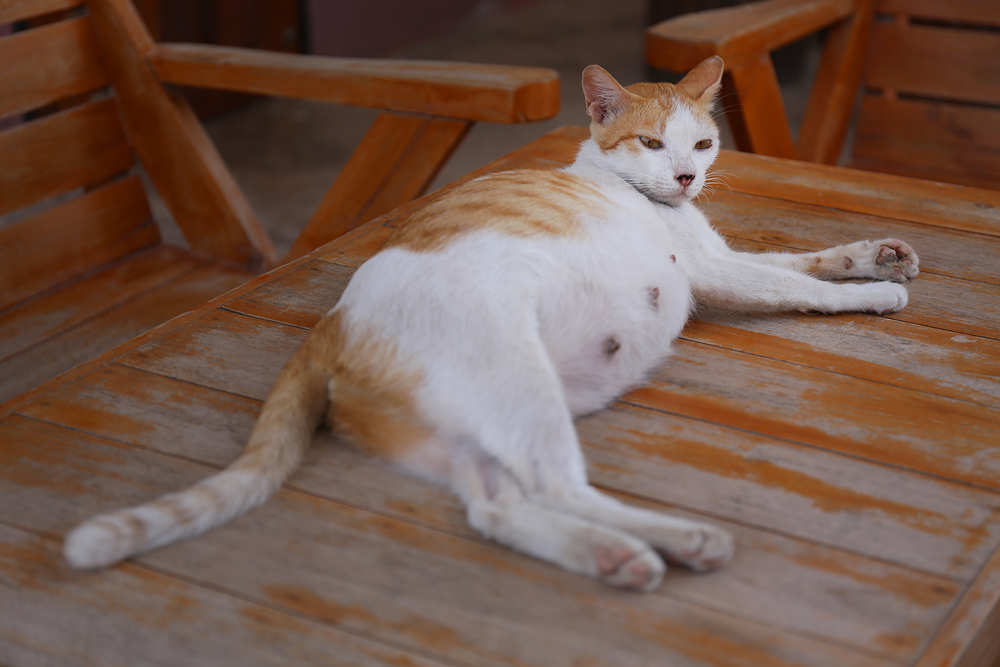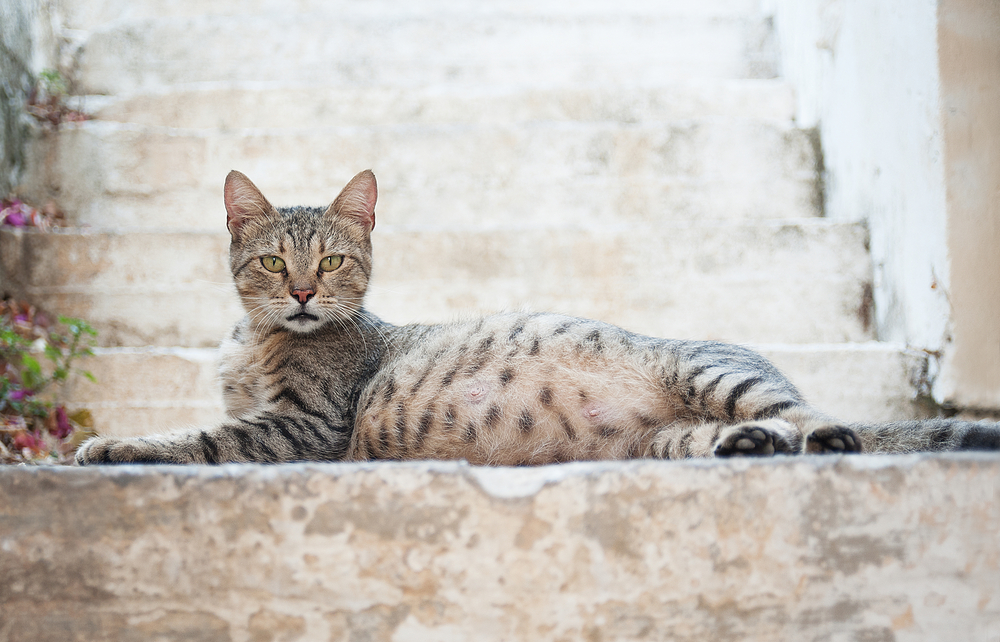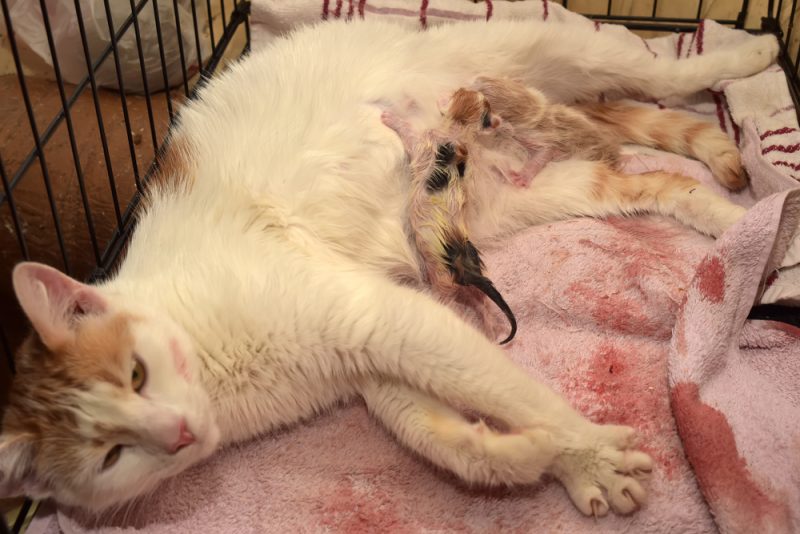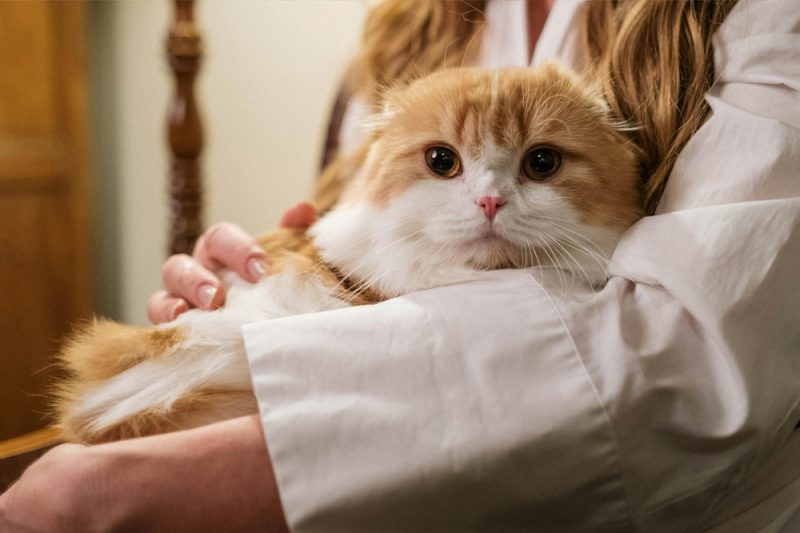- July 21, 2024
Do Cats’ Waters Break? Our Vet Explains Feline Pregnancy Facts


The information is current and up-to-date in accordance with the latest veterinarian research.
Whether you’ve experienced it yourself, know someone who has, or watched it on practically every sitcom in existence, you know what it means when a pregnant woman’s waters break—it’s baby time!
If you’re awaiting the arrival of some kittens, you’ll want to know what to be looking out for. Will there be contractions, panting, screaming, and crying? Will you see the telltale sign of their waters breaking? The answers are yes, sometimes, no, not usually, and not exactly.
So, what does a cat’s water breaking look like? For everything you need to know about what happens when a cat gives birth, keep reading.

What Waters Are Breaking?
For humans, when the fetus is ready to leave the safety of the womb, the cervix dilates, causing the mucus plug that has been blocking the entrance to the uterus to dislodge, and the amniotic fluid surrounding the baby rushes out, sometimes discreetly, sometimes all over your shoes.
With cats, there are usually multiple fetuses inside the womb—typically around four to eight, with each contained within their own amniotic sac. Much of the time, the kitten is delivered still enclosed within the sac, so no amniotic fluid comes out before the birth. If the sac does break before the kitten is delivered, you may notice a very small amount of fluid coming from the mother cat’s (queen) vulva, but most of the time, she will clean it up before you’ve had a chance to notice anything. The fluid may be clear, greenish, or pink-tinged. Brown, red, yellow, or black discharge means it’s time to phone the vet.
So, if you’re expecting a dramatic flood of fluid to let you know that kittens are on the way, you’re in for a disappointment. This is why cats so often manage to sneak off and deliver their kittens without anyone noticing.

What Are the Signs That My Cat Is in Labor?
If we can’t rely on breaking waters to let us know that a cat is in labor (also called queening), what other signs can we be looking out for? Cats are notoriously stealthy when it comes to giving birth, and often, the first sign we will see is the sudden presence of kittens by her side! Most cats prefer to give birth in private, so don’t be too committed to the idea of holding her paw through the process.
If you want to know when kittens are on the way, here are a few signs you can watch out for:
- Nesting: This might include gathering blankets, getting comfortable in a bed you’ve provided, or finding herself a cozy spot of her choosing.
- Pacing: As the kittens are shifting into position and contractions are starting up, your queen may pace and seem uncomfortable or unsettled.
- Vocalizing: For cats, birth is normally a fairly quiet affair, but some cats might let out some small meows, squeaks, or squawks if things get a bit uncomfortable, particularly if this is their first litter.
- Licking: One of the main reasons you’ll see very little in the way of discharge before, during, or after the birth of kittens is that the queen will be focused on cleaning her vulva, the kittens, and any fluids. This is an evolved survival technique, minimizing the scent of newborn kittens that could attract predators.
Before a kitten appears, you will usually see a “bubble” appear at the entrance to the vagina. This is the amniotic sac. The queen will usually take care of breaking the sac and crushing the umbilical cord, so only intervene if there seems to be a problem.
How Long Will Labor Last?

Once queening has commenced, expect to see a kitten at least every hour, but it is not unusual for the delivery to be much quicker than this. It is also not unusual for there to be a pause in the delivery for the queen to rest, and many cat owners have woken the next morning to find two or three more kittens!
What Are Signs of Problems?
In the vast majority of cases, cats will deliver their kittens with very little difficulty and without the need for human intervention.
However, there is always a chance of things going wrong, so here are some red flags to look out for:
- Lots of licking, but no kittens after 1 to 2 hours
- Brown, black, red, or yellow discharge
- Lethargy in queen or kittens
- Lack of interest in kittens or not allowing them to suckle
- Crying, pacing, and distress—a little is normal, but if it continues, there is likely a problem
Be sure to have your vet on speed dial in case you have any concerns or are in need of advice.

Should I Let My Cat Have Kittens?

It is a common myth and misconception that female cats should be “allowed” to have a litter before they are spayed. There is absolutely no scientific evidence to support this notion, having come from the anthropomorphic (applying human emotional experiences to other animals) idea that all females should experience motherhood.
If you are thinking about breeding your cat, first consider these statements:
- Tom cats have a barbed penis, so intercourse is unlikely to be an enjoyable experience for females. Males also usually grip the female’s scruff in their teeth to stop them from getting away.
- Kittens are weaned when they are 6 to 8 weeks old, and female cats often don’t tolerate their offspring hanging around much beyond that.
- There are around 30 to 40 million cats in animal shelters across the US.
This is why our advice is to spay and neuter your cat. However, if you really want to allow your cat to have a litter, then please ensure that you have already found a loving home for all of the kittens. However, by bringing more kittens into the world, you would be taking away the opportunity for already existing kittens to get adopted.

Final Thoughts
If you are waiting to see your pregnant cat’s waters break, you are likely to be disappointed. Although they technically do experience a similar process to that seen in humans, the volume of “water” is so small that it’s likely to be missed, if not already cleaned up by the queen before you have a chance to see it. Additionally, most kittens are born still contained within the amniotic sac, so the fluid is contained until after the birth.
It’s important to be aware of what is and isn’t normal when it comes to queening, but even more important is knowing that there are millions of cats in desperate need of homes, and adding to that population unnecessarily is something that should be carefully considered. So, it’s often best to spay or neuter your cats.
Featured Image Credit: Boy67, Shutterstock
Tags
What do you think?
Related Articles

New Puppy Checklist: Gear You’ll Need for Your New Dog
Getting a new puppy is really exciting, but before you welcome them home, it’s important to prepare your space for them. Since puppies need a

How Big Do Mini Poodles Get? Vet Reviewed Average Weight & Growth Chart – Dogster
The information is current and up-to-date in accordance with the latest veterinarian research. Learn more » When you buy a Miniature Poodle, you might not

Can Police Dogs Smell Nicotine? Vet Verified Facts & Info – Dogster
The information is current and up-to-date in accordance with the latest veterinarian research. Learn more » While cigarette sales have been declining steadily for decades,

How Old Is 5 in Dog Years? Vet-Approved Guide to Each Size of Dog – Dogster
The information is current and up-to-date in accordance with the latest veterinarian research. Learn more » A common method for calculating a dog’s age is

